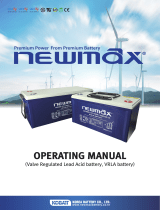
Applications
Table 1 below gives description of the range of reserve power
applications covering stable grid, unreliable grid and off grid
applications – the superior performance characteristics of SuperSafe
SBS EON Technology make it the ideal solution to be used in these
applications.
Whilst SuperSafe SBS EON Technology solutions are well proven
in standby applications, recent developments have focused on
improving robustness in harsh environments and challenging operating
conditions. Today EON Technology has higher cyclic performance,
improved endurance at high temperature and the ability to operate
in partial state of charge conditions, providing that the operating
conditions are well understood.
Application Battery Demands Suitability
Reliable Grid Stable grid
Controlled ambient tempature
Compensated float voltage
Very little cyclic use
Yes
Grid Assist Regions where grid is supported with
scheduled outages
Reasonable temperature control
Compensated float voltage
Medium level cyclic use
Yes
Unreliable Grid
(Low risk of
PSoC)
Poor grid stability
Frequent power outages / scheduled &
unscheduled
Poor temperature control
High cyclic use
Cycles can be shallow / deep
Low risk for uncontrolled Partial State of Charge
Yes
Unreliable Grid
(High Risk of
PSoC)
Poor grid stability
Frequent power outages / scheduled &
unscheduled
Poor temperature control
High cyclic use
Cycles can be shallow / deep
High risk for uncontrolled Partial State of
Charge
Yes
Off Grid
Controlled Full
State of Charge
Regular cyclic duty
Battery is returned to full state of charge
between cycles
Battery can be exposed to fluctuating
ambient temperature
Balances Opex and battery life
Yes
Off Grid
Controlled
Partial
State of Charge
Regular cyclic duty
Battery is deliberately operated in Partial State
of Charge condition
Battery is periodically returned to Full State of
Charge
Battery can be exposed to fluctuating
ambient temperatures
Designed to maximise Opex savings
Yes
Table 2 provides a summary of the operating parameters (charging) that
will deliver optimum service life and performance relative to the type of
application.
Application SuperSafe® SBS EON Technology®
Charge Parameter for Optimised Life
and Performance
Reliable
Grid
4Temperature compensated float voltage equivalent to
2.29Vpc @ 20°C
4Charge current - minimum 0.1C10A, maximum unlimited
Grid Assist
4Boost voltage equivalent to 2.35Vpc to 2.40Vpc @
20°C to fast charge
4Charge current – minimum 0.1C10A, maximum
unlimited
4Followed by float voltage with temperature
compensation applied as required
Unreliable Grid 4Boost voltage equivalent to 2.35Vpc to 2.40Vpc @
20°C to fast charge
4Charge current - minimum 0.1C10A, maximum
unlimited
4Followed by float voltage with temperature
compensation applied as required
Hybrid Operation to
Full State of Charge
4Boost voltage equivalent to 2.35Vpc to 2.40Vpc @
20°C
4Charge current - minimum 0.1C10A, maximum
unlimited
4Return to full state of charge between discharge cycles
4Optimum charge factor 103% of discharged Ah
Hybrid Operation in
Partial State of Charge
(controlled PSoC) -
Example
4Boost voltage equivalent to 2.35Vpc to 2.40Vpc @ 20°C to
return to 95% state of charge
4Charge current - minimum 0.1C10A
4Full recharge every 10 days
4EnerSys will consider variations in controlled PSoC
operation as necessary - please contact your local
representative to discuss details
Operating Temperature Range
The recommended operating temperature range for optimum life and
performance is 20°C. However, SuperSafe SBS EON Technology
monoblocs and cells can be operated in the temperature range -40°C
to +50°C.
In order to maintain mechanical integrity of the plastic components, the
battery temperature in operation should not exceed +50°C.
Storage
Monoblocs and cells lose capacity when standing on open-circuit
because of parasitic chemical reactions. The self-discharge rate of
SuperSafe SBS EON Technology monoblocs and cells is very low
because of the high purity of the grid lead and electrolyte. Monoblocs
and cells should be stored in a cool, dry area. High temperature
increases the rate of self-discharge and reduces storage life.
Figure 1 shows the relationship between open-circuit voltage (OCV)
and storage time at various temperatures.
2
Table 1
Figure 1
2.16
2.15
2.14
2.13
2.12
2.11
2.10
96
91
87
83
79
74
70
Open Circ uit Volta ge per Cell
Approx. State of Charge (%)
Months
0612182430364248
+40°C+30°C+25°C+20°C+10°C
+40°C +30°C +25°C +20°C +10°C
Table 2






